- Introduction
- The Chantry School
- KM Free Grammar
- Malham
- Malham Girls School
- Scosthrop
- Malham Tarn
- KM United School
- Airton
- Lee Gate & Bordley
Clicking on most pictures will show a larger version
List
of Teachers 1875 - 1974
Including Assistants, Pupil Teachers and salaries.

The Scosthrop school building initially housed the Airton School, which took it over in 1875.
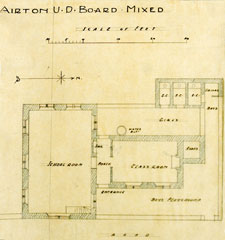
Plan of the Scosthrop school building when it was in use by Airton School.
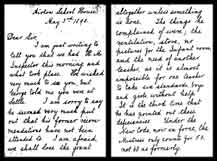
The aftermath of the School Inspection 1878.
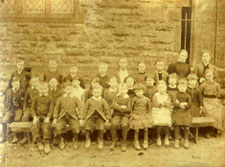
Airton School photo taken toward the end of the 19th century.
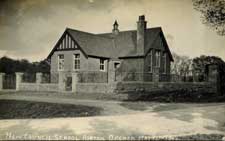
Originally the School was housed in the school building at Scosthrop and then moved to the newly built school overlooking Airton green, which opened on May 17th 1917.
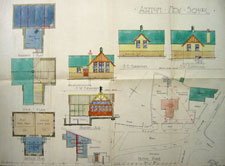
Plan of Airton New School.
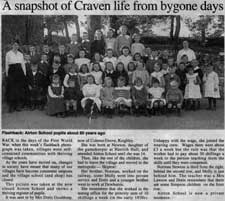
Airton School pupils and staff taken about 1916.
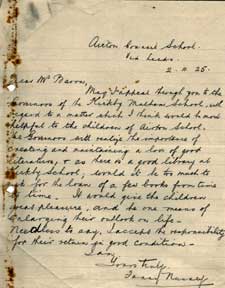
1925 - A shortage of books!
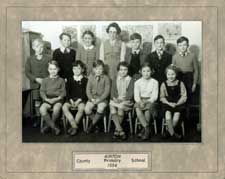
Airton primary School pupils 1954
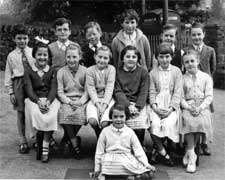
Pupils photographed in the school yard 1954/55 (named)
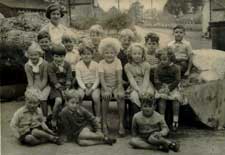
The Airton infants class of 1959 (named).
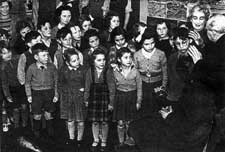
The BBC made "Children's Hour" at the school in February 1951.
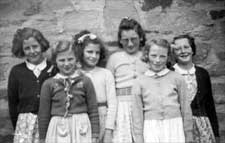
"Smile please" pupils from the early 1950s (named).
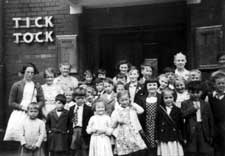
School trip in the early 1950s.
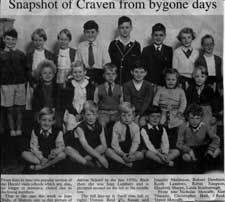
Airton pupils from the late 1950s.
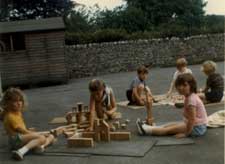
Taken in 1973, shortly before the closure of Airton school.
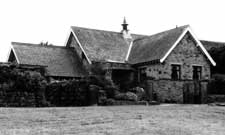
The redundant school building was converted into a house.
The History of Education in Malhamdale
Airton School (1875-1974)
In January 1875, the Trustees of Scosthrop School were given a ‘Final
Notice’ of the inadequacy of the education provided by the school
and this notice was to expire in July of that year. The Education Department
required that the school should be made a Public Elementary School by
the engagement of a certified teacher, and the school was to be conducted
in other respects according to the provisions of the 1870 Education Act.
The Department calculated that according to the population of the four
townships of Airton, Scosthrop, Calton and Otterburn, 74 school places
were necessary.
In order to discuss this situation, a meeting of the ratepayers was called
in March 1875 with Rev T C Henley in the chair. The main issue was that
to comply with the demands of the Education Department, a minimum of £50
would need to be raised in addition to the present income of the school.
This could either be achieved by private subscription or by raising a
voluntary rate with a suggestion that it be paid half by the landlords
and half by the tenants. The alternative was the formation of a School
Board for the four townships as a United District. It would then be the
job of the School Board within twelve months to either rent Scosthrop
schoolroom, if terms could be agreed with the Trustees, or to build a
new school, an idea for which there was very little support. The chief
objection to the formation of a School Board was the cost of the election
of the members.
After several meetings of the ratepayers, the Airton School Board was
finally elected on October 30th 1875. It consisted of:-
Rev T C Henley, Chairman
Mr W Gomersall, Vice-chairman
Mr J B Dewhurst
Mr R Brown
Mr R Mount
Mr C A Rickards and
Mr E Taylor
The members were apparently chosen amicably at a ratepayers’ meeting
and elected without a contest, raising their first precept of a two penny
school rate on April 12th 1876, which provided the £54 required.
However, all was not plain sailing for the Board. They had been unable
to agree to lease the Scosthrop school buildings from the two Trustees,
the Vicar and Mr Thomas Preston, because of a difference of opinion between
the two men, so an appeal was made by Rev Henley and the Board to the
Charity Commissioners to appoint additional Trustees, and on July 11th
1876 the following people were appointed:-
William Alcock of Newfield Hall, Banker
John Bonny Dewhurst of Aireville, Skipton, Manufacturer
William Gomersall of Otterburn
Anthony Taylor of Airton and
Edward Taylor of Airton, Gentlemen.
While all this was in progress, the Board had hired a cottage as a teacher’s
residence and Miss Moore was appointed as Mistress.
On 8th November 1876, an agreement was finally settled on the use of the
Scosthrop School premises for the modest rent of 5 shillings per annum
with the Trustees reserving the use of the buildings on Sundays and evenings.
Due to the lack of any Log Book or Minute Book, little information is
available about life in the early days of the school. The main source
of information is from the published accounts of all the schools and the
Vicar’s letter, in the Church annual reports. From these we learn
that Miss Moore only stayed as Mistress for one year, to be followed by
Miss Paley in 1876 and Miss Alice Smith from 1877 to 1881. In fact the
turnover of staff was quite rapid with 9 mistresses, 1 master, 2 assistants,
6 pupil teachers and a sewing mistress recorded in the years 1875 to 1900
(with two years, 1892 –94, not recorded). The number of pupils varied
from 44 to 73.
In 1883 a note appears at the bottom of the accounts stating that ‘A female pupil teacher is wanted for the school at a salary of £8 increasing by £2 a year during the engagement.’
Space to accommodate the scholars must have been difficult because we
know that the enlargement of the classroom and the building of new "offices" ie. toilets,
cost the Airton School Board £26. 10s in 1887/8.
Other references in the Vicar’s reports remind us of the hard conditions
suffered by some of the children who also worked as half-timers at the
mills. A reference for 1891 tells us that the annual Government Inspection
was due on Monday June 22nd, and any scholar wanting a half-time or whole
time exemption certificate for the next twelve months, had to give notice
to the head teacher before that date. (The granting of certificates was
dependant on certain standards being achieved at the Inspections.)
The following year the Vicar writes an explanation of coming changes
to the employment law. After September 4th 1892, no child between the
ages of 13 and 14 was to be allowed to work, either as a half-timer or
a full-timer at the mills, unless he had passed the exemption standard
which at Airton School Board District was the fifth standard, or else
held a ‘dunce’s certificate’, so a child who had
been working with a half-time certificate had to cease working at 13 to
attempt to achieve this standard in his final year. More radical still
was that after January 1st 1893, no child under the age of 11 could become
a half-timer at a mill!
Illness was also a regular occurrence. Airton School Board was closed
by order of the Medical Officer of Health in 1892 to prevent the spread
of scarlet fever.
Other changes in education were also taking place around this time. In
1891 the Education Department offered a Fee Grant to the school. This
was a sum of 10s per pupil and was to replace the fees collected from
parents, so from September of that year, education at Airton as well as
at Kirkby Malham United School and Malham Moor School was free.
Despite these changes, other problems were emerging. In 1898 following a visit from the Government Inspector, the then Mistress Julia Guttery, wrote a letter to an un-named person but presumably to a member of the Board, pointing out that the Government Inspector’s previous recommendations had not been addressed. She wrote:
‘The things he complained of were; the ventilation, stove, no pictures for the Infant Room and the need of another teacher, as it is almost impossible for one teacher to take six standards, boys and girls, without help. It is the third time he has pointed out these deficiencies.’ She was concerned ‘…we shall lose the grant altogether unless something is done.’
(For the year 1897/8 the school had 62 scholars and she was the sole mistress with only the help of Pupil Teachers.) Unfortunately we do not know the full reply to this plea but we do know that the accounts after that year, show that both a Mistress and an Assistant were employed.
As a result of the 1902 Act, School Boards were abolished and both elementary
and secondary education became the responsibility of County Councils,
known as Local Education Authorities or LEAs. Board schools became known
as ‘Provided Schools’. The Trustees of Scosthrop School gave
the required six months notice of the tenancy of the buildings, but as
always, there was much discussion about procedure and two lively meetings
before the Airton School Board finally ceased to exist and the School
was handed over to West Riding County Council and became Airton Provided
School on March 31st 1904, with the school continuing in the Scosthrop
building.
Mr Edward Taylor who had been the longest serving member of the old School
Board, gave a tea to the scholars on his birthday in 1906, and the following
year gave a sum of £9 to be invested for a yearly prize, to be given
alternately to Airton and Kirkby Malham Schools.
Conditions for the welfare of the children improved under the LEA and
from January 1st 1908 it was their duty to provide medical inspection
of the schoolchildren. The Skipton Medical Officer was Harry Stansfield.
But if the health of the children was improving, the state of the buildings
certainly was not. The Trustees of Scosthrop School, together with a number
of ratepayers, made a strong effort to persuade the County Council to
put the school buildings in a state of repair suitable for the needs of
the school area and prevent an increase in rates by the building of a
new school. The ratepayers had the moral support of the Board of Education,
but the will of the County Council prevailed and a new school was to be
built. There was much wrangling with various plans, maps and solicitors’
letters involved, but after many meetings, the building commenced in 1913,
on land sold to WRCC by William Morkill of Newfield for £550 on
the site overlooking the green. The children were in the new building by March 1915 when the next school inspection took place.
There was accommodation for a class of 40 mixed juniors taught by Miss
Thompson and 30 infants taught by Miss Thwaite of Cowper Cote Farm.
Craven Herald of December 8th 1916 reports that the scholars, their
mothers and children under school age, were treated to tea in the Wesleyan
School at the invitation of Miss Garnett-Orme of Scosthrop House. Songs
were sung by the scholars and a lantern slide show was arranged for the
children. No doubt in the middle of the period of the war, this was a
great treat for the children.
From 1922 to 1929 when Ruth Earnshaw attended the school, the teachers
were two sisters, the Misses Nussey who lived on Settle Road. One was
a certified teacher and the other was not. There were approximately 46
scholars over that period. There was one large room divided into two rooms
by a partition, the infants in one room and standards 2 to 5 in the other.
The infants’ section had a coal fire but the juniors’ classroom
was heated by pipes and radiators from a coke stove in the cellar. The
curriculum concentrated mainly on the three Rs, but sewing poetry and
art were also included. Stool ball was played, sometimes against Kirkby
Malham School, and drill also featured. Discipline was strict and the
cane was often used. The leaving age was 14 unless pupils passed the selection
examination at 11 for the High School or Ermysteds in Skipton. There was
no transport provided so some children walked long distances to school
and brought sandwiches for lunch. Some were able to go home but others
took their lunch to friends or relatives in the village.
Perhaps the children at Kirkby Malham United School were more fortunate
in the facilities provided for them, because in 1926 Fanny Nussey wrote
to Rev Baron asking if it was possible to have the loan of a few books
from time to time, from the library at Kirkby School. She wrote ‘It
would give the children great pleasure, and be one means of enlarging
their outlook on life.’
It is remembered that school life over that period was not very exciting,
so no doubt the annual school trip to Morecambe was greatly anticipated
and enjoyed at a time when few people took holidays and treats were rare.
It involved the children walking to Bell Busk station to catch the morning
train, then the day being spent at the seaside before returning by train
and finally walking back to Airton. Another treat was the June Tea Party,
a joint venture with Kirkby Malham School. Tea was provided in the Church
Hall, following school sports. Coniston Cold School used to send a team,
but for the relay only. This was their strong event which they usually
won, much to the annoyance of the other competitors!
In 1934 Miss Carter became the Infant Teacher and the following year
Miss Collin was appointed Headmistress. Miss Carter lived in Settle and
for many years cycled to Airton each day. After the introduction of the
school taxi, she made use of that service for at least part of her journey.
Miss Collin lived at Wayside Cottage in Airton.
One of the reforms of the Education Act 1944 was that secondary education
was to be available for all children from 11 years of age, and it was
to take place in separate schools specifically for that purpose. These
changes were introduced over the next few years meaning that all children
at 11 years took the scholarship examination to determine which school
they were to attend, either Ermysteds Grammar School, Skipton Girls’
High School or initially Barnoldswick Secondary Modern School, later Aireville
School in Skipton. Miss Collin kept an Honours Board and any child passing
the scholarship exam, or gaining any other outstanding achievement, had
their name placed on this Roll of Honour.
Marion Wellock, a pupil at the school from 1947-53 and Joan Barker (nèe
Scarborough), a pupil from 1949-55, remember many details of school life
during these years. There was free milk supplied by W Sharp of Skellands
Farm which came in small bottles with a cardboard lid on each. The bottles
were placed near the pipes in winter to take the chill off them. School
meals originally costing 1 shilling were introduced. They were cooked
at Hellifield School and transported by car in large containers. Transport
was also provided, with a taxi from Beecrofts of Long Preston collecting
children from the farms, Hull House, Goal Farm, Wenninber Farm and the
village of Otterburn.
The school day started with an Act of Worship in addition to Scripture
lessons two or three times a week. Piez ball (rounders without a bat)
was played and drill was something of a team effort. Nature walks took
place in summer and dancing was a regular lesson enjoyed by most. It
was held for Standards 2 to 5 every Wednesday afternoon from 2.30 to
3.30 with Miss Collin as the teacher and Margaret Bolland playing the
piano. One of the outstanding memories of Marion and Joan’s schooldays
was the day when the BBC came to Malhamdale in February 1951, to record
for Children’s Hour. The producer was Gwen Payne and Bertha Lonsdale
assisted, possibly as the pianist. The junior children of Airton School
sang the spiritual ‘Swing Low Sweet Chariot’. They also recorded
part of the Christmas pantomime, Goldilocks and the Three Bears, performed
in Airton Chapel Sunday School, which was produced by Mrs Mary Mason.
This was a major event – they were going to be on the wireless!
In the early 1950s Miss Carter went to College for a year to further
her training and was replaced for that time by Mrs Clark from Malham.
Mrs Hodgson from Gargrave also taught at Airton for a short time. Miss
Collin retired in 1958 and was replaced by Miss Roberts who was the sole
teacher after the retirement of Miss Carter in 1972, until the school
closed in 1974.
The number of scholars in the early 50s was approximately 30, and as with many small schools, the decision was taken to close the premises and transfer the pupils to Kirkby Malham United School, leaving just one school in the Dale from 1974. The school building was sold in the late 1970s and became a private residence.